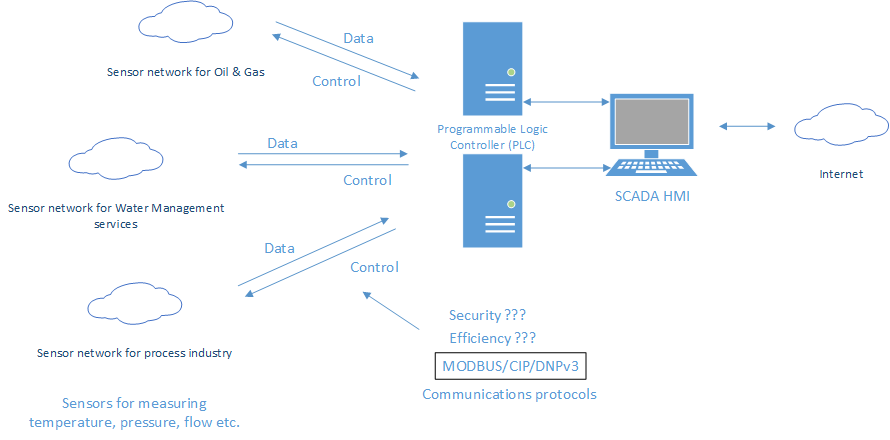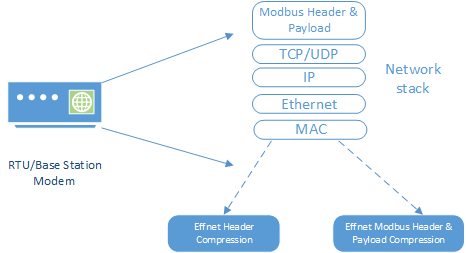Solution for Industrial Communications
Many industries such as oil and gas, mining, utility, public safety and military, transport and government use low bandwidth (narrowband) wireless networks for many applications. These point-to-point or point-to-multipoint networks typically use VHF or UHF, support voice and data and deliver applications like SCADA with monitoring and control, public safety or disaster relief. On these networks, legacy communication protocols are being replaced by protocols based on Internet standards such as Ethernet and IP. There are inherent benefits of this transition to improve connectivity, accessibility and reusability of applications at much lower costs, both capex and opex. However, there are challenges in maintaining efficient use of the available bandwidth with the added overheads of the new protocol layers and security of data and systems.

Figure 1: Examples of industrial communication networks
The Ethernet family of networking standards is firmly established on the wired and wireless networks either in the form of 802.11 or bridging/routing Ethernet over wireless radio. This has proven to be a highly cost effective way of connecting two or more remote networks.
Modbus is one of the most common protocols used in industrial communications. With the transition to IP and Ethernet based communications, it has been adapted to be carried over IP in the Modbus-TCP standard. The other most commonly used protocols are Common Industrial Protocol (CIP) and DNPv3. As it is not feasible to simultaneously update all nodes of a legacy system based on serial communications to Modbus-TCP, there are intermediate solutions available which carry the legacy serial protocol encapsulated in IP protocols, such as Modbus over TCP/IP and Modbus over UDP.

Figure 2: Effnet solutions for efficient and secure use of the network
Effnet has developed its header and payload compression portfolio consisting of Effnet EthHC, Effnet ROHCv2 and Effnet ROHC-TCP with extended support for compression of Modbus headers and payload. This enables compression of Ethernet, IP, UDP, TCP and Modbus headers together with Modbus payload data.
There are many advantages of using the Effnet header and payload compression portfolio:
- Supports compression of both IPv4 and IPv6 (future-proof)
- Supports compression of Ethernet, TCP, UDP, ESP and IP headers together with the Modbus header and payload
- Significantly reduces header overhead and payload size leading to
-
- Bandwidth savings
- Reduced latency
- Reduced bit errors and packet loss
- More users and/or terminals on the same link
- Robust and compression efficient operation even in bit error, packet loss and reordering conditions.
- Highly modular implementation; possible to add further products from the portfolio with minimal additional integration work

Figure 3: Complete packet which carries Ethernet/IP/TCP/Modbus/Payload is compressed

Figure 4: Packet size is significantly reduced after the application of header & payload compression
These savings are based on sample traffic containing a small Modbus payload. The compression efficiency would be higher for a larger Modbus payload and the degree of repetitive bit patterns in the payload.

Figure 5: A modular implementation with well defined API for quick integration
The Effnet header compression portfolio comprises Effnet ROHCv2, Effnet ROHC-TCP (Effnet Header Compression) and Effnet Modbus Header & Payload Compression. It is a modular implementation, so it is possible to start with one module or software product and add further modules or products as and when necessary with minimal integration efforts and maximum additional benefits.
Effnet’s Header & Payload Compression portfolio
Effnet’s Header & Payload Compression portfolio consists of the following products:
| Product | Usage | References |
|---|---|---|
| Effnet Modbus Header & Payload Compression | Modbus Header & Payload Compression | |
| Effnet ROHCv2™ | RTP/UDP/IP, UDP/IP, ESP/IP, IP | RFC4995, RFC 5225 |
| Effnet ROHC-TCP™ | TCP/IP | RFC 4996, RFC 6846 |
| Effnet EthHC™ | Ethernet |
Portability and ease of integration
Effnet’s ROHC product portfolio has been ported to and integrated on many different platforms. The operating systems include VxWorks, Nucleus, Linux, Windows (2000/XP), Solaris, FreeBSD and processors include PowerPC, MIPS, ARM, SPARC and x86. As the products are highly portable, they can be easily ported to many other operating systems, both real-time and generic as well as to other processors, both 32-bit and 64-bit regardless of byte-order.
- Highly portable code
-
- is written in ANSI C
- has variable types defined such that the variables behave the same way across different compilers.
- is memory alignment safe.
- is endianess independent.
- does not require OS timers and does not have OS dependencies.
- is re-entrant.
- A well defined Application Programming Interface (API)
-
- a set of functions and parameters.
- documentation and sample application code.
- provides control of memory management.
- provides control over multi-threading of the application.
- Small memory footprint and low CPU power requirement
- A sample application demonstrates how to use the API which speeds-up the integration process.
- Interoperable
-
- Has been extensively tested during field tests by customers, all the ROHC interoperability tests conducted by IETF and internal rigorous quality process.
Additional features
In addition to the features specified in the standards, the Effnet ROHC product portfolio has the following efficiency and robustness improving features:
- Full featured and efficient classification and context management module.
- Highly efficient compression and decompression using field pattern change detection algorithm and link layer information when available.
- Support for handover via context re-initialization.
- Support for AT reboot via feedback options, the decompressor reinstates the compressor context information.
- Mechanisms to reduce usage of feedback channel.
- Support for chained memory buffer.
- Interactive statistics and callback functions.
-
- User can read and/or reset statistical information at desired time intervals. The callback functions provide useful state information.
- Dynamic channel parameter configuration.
- Adaptive mechanisms for improved compression efficiency & context damage detection under various channel conditions.
All additional features above are transparent with regard to interoperability.
Effnet Classifier and context manager
Packet classification and context management is essential to header compression. Effnet provides this additional module together with the Effnet ROHC product family.
Effnet Modbus Header & Payload Compression™
Modbus has been and still is the de facto industrial communications protocol. It is a serial communications developed in 1979 and has evolved into many variants including Modbus-TCP, Modbus over TCP/IP, Modbus over UDP. The Modbus header is 7 bytes long and can carry a payload of up to 253 bytes.
Effnet Modbus Header & Payload Compression is an extension of the Effnet ROHC-TCP framework supporting compression of Modbus-TCP (both header & payload) to deliver additional value and higher bandwidth savings. The Effnet packet classification and context management module is able to detect TCP packets carrying Modbus header & payload and separate those into packet flows that are compressed separately from typical TCP flows.
Effnet ROHCv2™ (ROHC profiles Uncompressed 0x0000, RTP 0x0101, UDP 0x0102, ESP 0x0103 and IP 0x0104)
Effnet ROHCv2 has been designed to deliver high compression efficiency and robustness on wireless links using minimal system resources. The bit error rate, frame error rate and packet loss are comparatively much higher on wireless links than on the wired links. Depending on the network architecture and operation packets may also experience reordering. All these challenges must be overcome to minimize error propagation and deliver high compression efficiency. This requires an advanced compression algorithm that takes into account these link conditions and that is able to detect header field patterns to deliver high compression efficiency with robustness. Effnet ROHCv2 is the highly system efficient (minimal CPU and memory utilization) implementation of that advanced and complex algorithm.
Effnet ROHCv2 can compress header chains comprising of IP/UDP/RTP, IP/UDP, IP/ESP and IP where IP could be one or more IPv4 or IPv6 headers.
Effnet ROHC-TCP™ (ROHC profile RTP 0x0006)
Multiple Internet packet size studies* are in agreement that at least 40% of all IPv4 packets carry no or only a few bytes of payload i.e. packet sizes are at or very near to header size (IPv4+TCP). One study of IPv6 packets shows the same trend. Even more remarkable in that study is that for IPv6, 60-80% of the packets carry more header data than packet data. Effnet ROHC-TCP™ would be very beneficial in these cases.

Figure 7: Significant benefit of ROHC-TCP over uplink due to small packets and payloads
| Average packet size (w/o ROHC) (bytes) | Average packet size (w ROHC) (bytes) | Savings (%) | |
|---|---|---|---|
| IPv4/TCP Ack (w/o options) | 40 | 10 | 75 |
| IPv4/TCP Ack (Timestamp) | 52 | 13 | 75 |
| IPv4/TCP HTTP GET (basic) | 70 | 40 | 43 |
*Packet size studies at www.caida.org
Effnet Ethernet Header Compression™ (Effnet EthHC™)
Ethernet is the dominant link layer technology used to carry IP traffic. When Ethernet packets are carried over networks with their own standardized link layer technology, the Ethernet header represents an overhead. Effnet EthHC™ can efficiently compress the Ethernet header overhead. It is designed to work in perfect symbiosis with the Effnet ROHC™ product portfolio. It is possible to save even more bandwidth by efficiently compressing Ethernet headers and reducing overhead along with IP/UDP/RTP, IP/UDP, IP/TCP and IP/ESP headers. Effnet EthHC™ can also be used as an independent product.
Maintenance and support
The Effnet ROHC product portfolio is offered with a full range of support services, including problem reporting, bug fixes, updates, training, consulting and integration services. A team of engineers experienced in standardization of header compression technology, implementation and testing of product portfolio is available for support and consulting services.
Licensing
For licensing of the Effnet ROHC product portfolio, complete or individual products, please contact us at info@effnet.com.

Figure 8: An example of header compression by Effnet ROHC™ portfolio
